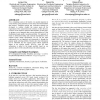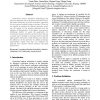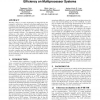40 search results - page 3 / 8 » Impact of hardware emulation on the verification quality imp... |
DAC
2009
ACM
14 years 19 days ago
2009
ACM
For a computing system to be trusted, it is equally important to verify that the system performs no more and no less functionalities than desired. Traditional testing and verifica...
ICCAD
1996
IEEE
13 years 10 months ago
1996
IEEE
Functional simulation is the most widely used method for design verification. At various levels of abstraction, e.g., behavioral, register-transfer level and gate level, the design...
CSCWD
2009
Springer
14 years 12 days ago
2009
Springer
Constrained random simulation methodology still plays an important role in hardware verification due to the limited scalability of formal verification, especially for the large an...
FPL
2007
Springer
13 years 9 months ago
2007
Springer
Recently, there is a surge of interests in using FPGAs for computer architecture research including applications from emulating and analyzing a new platform to accelerating microa...
MICRO
1999
IEEE
13 years 10 months ago
1999
IEEE
Building a high-performance microprocessor presents many reliability challenges. Designers must verify the correctness of large complex systems and construct implementations that ...



